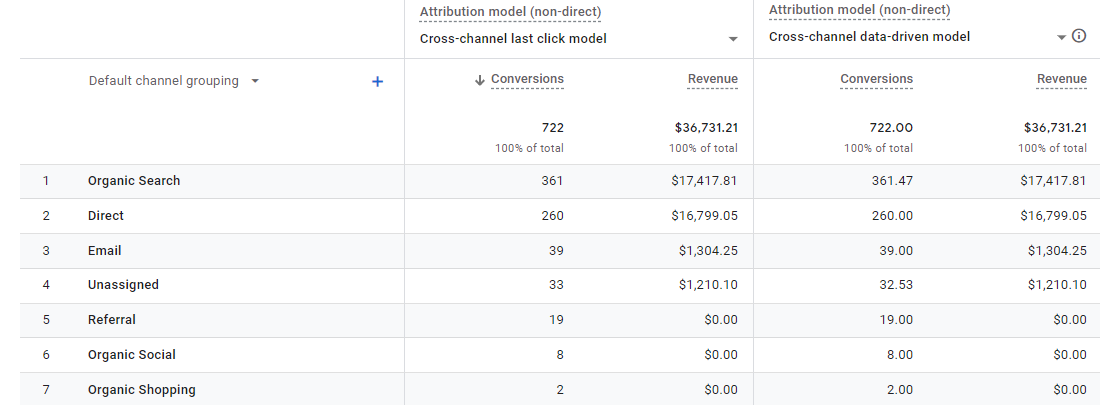
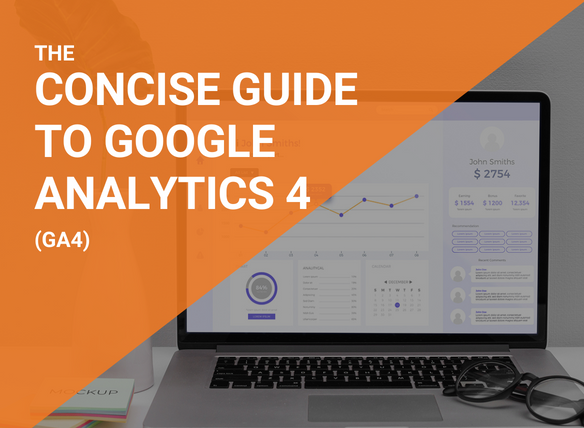
You will still be able to get access to your historical GA3 data after this date, but as Google announced here, “All standard Universal Analytics properties will stop processing new hits on July 1, 2023.”
Yes, this is next year, but NOW is the time for action. Here’s why…
The sooner you make the switch to GA4, the better for your business. GA3 will stop tracking mid-next year so you will need to use GA4 then anyway, but don’t leave it till then to make the change.
For good analysis, you need at least 12 months of data comparisons, so it will be best for your website to start using GA4 at least 12 months before July 1, 2023. When you collect more data over a longer period of time, you get better analysis and more meaningful reports with more helpful and insightful recommendations to help your business.
If you are setting up a new website, then GA4 can be added to your site now when the site is launched.
If you have an existing website that already has the old GA3, then you can have GA4 version added to your site and run both your existing GA3 and the new GA4 together. This will enable GA4 to start collecting the data you need, and help you become familiar with the new reports and insights GA4 provides.
It’s important to point out that Google Analytics 4 is still free to use. GA4 is a bit cleverer than the old GA3 and uses machine-learning to create AI-based insights. The new GA4 collects different datasets and more data than the old GA3.
Being cleverer, GA4 is a bit more complicated to set up than GA3, and needs to be correctly configured to provide the best results. The more complex the website, the longer it takes to configure. A small ‘brochure website’ may take 1 to 2 hours to install and configure GA4. A large ecommerce store website may take 6 to 8 hours to set up GA4 to accurately track all of the different customer events, sales funnels and conversions that are important to measure.
How long does it take to add the new Google Analytics 4 to my website?
It typically takes between 2 to 8 hours to add and configure GA4 correctly to track events and conversions on your website. We suggest to allow 2 hours for a basic set up of GA4 on a non-ecommerce website and 6 to 8hrs to track the important metrics on a larger and more complex ecommerce store. If you already have Google Tag Manager (GTM) installed, then it will be a bit quicker.
(There is more info below so scroll down for full details or click here.)
I thought Google Analytics is free so why are you charging me for this?
Yes, the use of the Google Analytics system is free for you to use. You can access the GA dashboard and extract usage reports at any time.
Concise Digital charges for our time to quickly and expertly set up and configure the GA system specific for each website. We also charge for our consultancy services to produce any special reports and to advise clients how to improve a website using the insights from the analytics reports.
Google makes its analytics platform available at no charge as it helps Google to sell more Google advertising. Google also gains massive amounts of data and intelligence through the collection of usage activities on different websites.
Why do I need to set up Google Analytics 4 now? July 2023 is a long way off.
The sooner you start collecting data, the sooner you will be able to track patterns of behavior and produce useful reports with meaningful and insightful recommendations. Our analysts suggest you need at least 12 months of data, so you will want GA4 added to your website by June 2022.
The more data the better for analytics and tracking, so give your website more time to collect data. When UA (GA3) is fully phased out, businesses that have adopted GA4 early will probably be getting better insights and recommendations in their reports and can reap even more tangible business benefits.
Why do I need Google Analytics anyway?
You don’t actually ‘need’ Google Analytics. You can live with out it and run a website that does not have Google Analytics on it, but why would you want to?
When it comes to business, ignorance is not bliss. Google Analytics unlocks the power of understanding how your visitors and customers use your websites. This behavioral data can drastically improve the results of your online business. Without behavioural data, optimizing a website’s performance is impossible.
Knowledge is power, and Google Analytics gives you the power to dramatically improve the results from your website. You can know who is visiting your website and when, where they came from, what device they used and what they did on your site. You know how long visitors stay, what they clicked, which visitors converted to leads and sales and much much more. And you can create segments to see which segments of visitors converted best and why.
Google Analytics is the best low cost way to gain this knowledge. It’s free to use, but it needs to be set up correctly.
Will I lose my Universal Analytics (GA3) historical data if I switch over to GA4? Can Universal Analytics and GA4 work alongside each other?
No, you will not lose data if you switch over to GA4. Universal Analytics (GA3).
And Yes, GA4 can work side by side with GA3.
We strongly recommend running both versions of Google Analytics side by side. This means that you can have both tools on your website at the same time. They will not interfere with each other, however keep in mind that GA3 will stop working from July 2023.
How long will the data from the current version of Google Analytics be available?
Google tells us that on July 1, 2023, the current version of GA3 called ‘Universal Analytics (UA)will cease to process new hits on websites, while the newer Universal Analytics 360 will stop tracking hits on October 1 2023.
After those dates, previously processed data in Universal Analytics will be kept for at least six months, which Google thinks is time enough for all users to download their historical reports. After this, Google may delete the data.
Is there any chance Google will change its mind?
We think it is highly unlikely that Google will delay the planned ‘end date’ of GA3, namely 1 July 2023.
At this stage, Google has said it will keep GA3 data for at least six months after that date,. We think it is highly likely that Google will keep this data for longer, but don’t rely on that. if you have historical reports you need from GA3, then make sure you get them in that 6 month period before December 2023.
The new Google Analytics 4 comes with a bunch of key features that make it very different from the old version. GA4 is all about “events.” These events are the main way that data is presented in the new Google Analytics.
One of the biggest differences is the new data modeling feature that uses machine learning bordering on Artificial Intelligence (AI) to fill in gaps in data. With a focus on privacy protection, the previous Universal Analytics is now often blocked by cookie-consent rules or blocked JavaScript.
The machine-learning processing means it can fill in gaps where businesses previously were not able to understand their complete customer base, such as when users opt-out of cookie usage and data collection.
Additionally the user-interface for the new default Google Analytics is very different. At first glance,GA4 can appear much more complicated to use than the previous version.
The biggest difference between traditional Universal Analytics and the new Google Analytics 4 is the user-interface.  There are also many differences in data collection between Universal Analytics and Google Analytics 4 properties – particularly in how data is defined and what data elements are called.
There are also many differences in data collection between Universal Analytics and Google Analytics 4 properties – particularly in how data is defined and what data elements are called.
The short answer is “Yes, and the sooner the better”. This is because GA4 provides extra features and improved techniques for gathering data. Better info helps you better understand what is happening on your website. For marketers, this can be very valuable, and GA4 can improve how you know and serve your website visitors and customers.
If you have an existing website, then Concise Digital recommends you add an additional GA4 Google Tag to your website that will then allow data to be captured and recorded in GA4. The current GA3 Universal Analytics tag will remain as well.
This will result in you continuing to have Google Analytics 3 as you currently know it running as normal, while also capturing new data in GA4.
Existing data from GA3 does not transfer over to Google Analytics 4. The datasets are quite different.
We recommend you run both versions simultaneously for at least one year until you gather at least a year’s worth of data on the new Google Analytics 4.
GA3 data will continue to be recorded until 1 July 2023, and your data will continue to be accessible for at least six months after that.
Some websites only require the basic set up of analytics, whereas business websites such as online stores benefit greatly from tracking the sources, pathways and sales conversions of their site visitors. This is usually best done with detailed event tracking and product sales conversion tracking as well. There are different variables to consider which is why the time involved to set Google Analytics up properly typically ranges from 2 hours to 6+ hours. If you already have Google Tag Manager installed on your website, then the total set up times will be a bit quicker.
Here is a summary table. Please scroll down for full details.
| Set Up Option | Set Up and Add to Website | Set up Tracking for Website Conversion Goals & Events | Estimated Time |
| GA4 Basic | Yes | Yes, basic event tracking | 2 hours |
| GA4 Advanced | Yes | Yes, detailed event tracking | 3 – 4 hours |
| GA4 Advanced eCommerce | Yes | Yes, detailed event tracking and sales tracking | 6 – 8 hours |
| Additional Options | Estimated Time | Frequency |
| Concise Report | 30 mins per report | Monthly, Quarterly or Ad Hoc |
| Q&A Session | Allow 15 mins to 1 hour | Monthly, Quarterly or Ad Hoc |
GA4 Basic: Set Up GA4 This typically takes about 2 hours, and includes setting up Google Tag Manager and Google Analytics 4, adding the GA4 code to a website, and setting up the basic configurations. This time estimate does not include any allowance for conversion tracking.
Tracking of conversions is one of the most important and most useful parts of Google Analytics and where all the time and effort of understanding your analytics can start to pay massive dividends. In Universal Analytics (GA3), tracking was done for Goals and Events. In GA4, everything is an ‘Event’, but conceptually it’s much the same.
As an example, the tracking of Goals and/or Events can include configuring the system so that clicks on your phone number and email addresses can be tracked in Google Analytics. Likewise, the submissions of forms can tracked, as can access to certain pages on the website or specific actions site visitors take on specific pages of the website.
This type of conversion tracking is very helpful, such as if you want to see which different traffic sources (SEO vs Ads vs Social vs Email) deliver which different types, quantities and qualities of conversions (phone/email/forms).
GA4 Advanced: Set Up Of GA4 With Conversion Goals & Events As a ball park estimate, this typically takes 3 to 4 hours to set up, including all of the set up explained in GA4 Basic above, plus the set up and configuring of conversion events in Google Analytics 4.
GA4 Advanced eCommerce: Set Up Of GA4 with Conversion Goals & Events We typically find it takes 6 to 8 hours to set up GA4 on a sophisticated eCommerce webstore, including configure GA4 to track your important conversion goals and events.
a.Regular Reports
b.Q&A Sessions
With both the old and the new Google Analytics platforms, you can access the information with on-screen reports directly from the system anytime online 24/7. A lot of our clients like to get our regular reports either monthly or quarterly that outline key trends, highlights, insights and often important actions to take.
The reports are customised to show you what is important for your website and are produced from your Google Analytics data. (Please scroll down to see below examples of what we can include in these customised reports.)
Reports can be prepared either monthly, quarterly or ad-hoc on request, and each report typically takes about 30 minutes to prepare. For ecommerce websites, monthly is often a suitable frequency, whilst for other websites quarterly is often satisfactory. As a baseline, a quarterly report is often a good starting point.
We recommend you set up GA4 now to start collecting website data in GA4 as soon as possible and start to get regular reports from this GA4 data. The preparation of the GA4 reports in addition to the GA3 reports may be an extra cost to you. Sometime before 1 July 2023, you will want to switch the source of the report data from GA3 to GA4 so the reports we prepare start drawing on the GA4 data.
Many clients also enjoy a quick Q&A session with us to go through questions that arise for them after they have digested their analytics report. These Q&A Sessions can be quick ad-hoc phone calls or may be regularly scheduled meetings either in-person or online.
Q&A sessions help to clarify issues or opportunities with the website as well as marketing, advertising and other business processes that could be improved. Often a short (and concise) focused discussion can quickly help to identify, plan and prioritise next action steps.
Just having Analytics on your website is never the answer. Business improvements do not come from simply having access to lots of historic data. It’s also possible to have too much information. No one wants confusing information or to suffer from the ‘paralysis of analysis’.
As with any other business information that helps you manage your business, your website’s Google Analytics data needs to be interpreted well with concise and meaningful reports with clear and insightful analysis.
Action steps arising from analytics reports do not need to be expensive or time-consuming to be valuable. Good Analytics reports can often help identify small ‘tweaks’ that can quickly bring big improvements.
The challenge is always to use the information wisely to find the key areas areas to focus on to cost-effectively improve and optimise future results.
Here are some examples of the valuable infographics we can prepare to include in custom analytics reports.
The Acquisition Overview summarizes data to help you understand how new users find your website and how existing users return to your site.

The Traffic Acquisition report shows data about new sessions from new and returning users.

Events provide insight into what’s happening on your site, such as user actions, system events, and errors. For example, events enable you to measure when users purchase a product, submit a form, or scroll through an article.

Conversions are user activities that contribute to the success of your business. You measure these activities using conversion events. This report shows data about each conversion event.

A cohort is a group of users who share a common characteristic identified by an Analytics dimension. For example, all users with the same Acquisition Date belong to the same cohort.
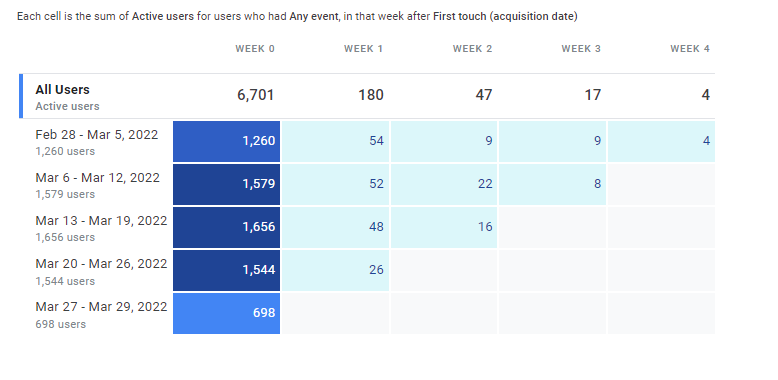
Ecommerce Funnel reports can be created to show you the percentage of customers who completed each step in the checkout funnel, compared to customers who completed the previous step in the funnel and the percentage of customers who abandoned the funnel.

Device Report shows the percentages of users on either Mobile, Tablet or Desktop devices. Analysis of which device users have can be added as a secondary dimension to other reports so you can assess results by device.
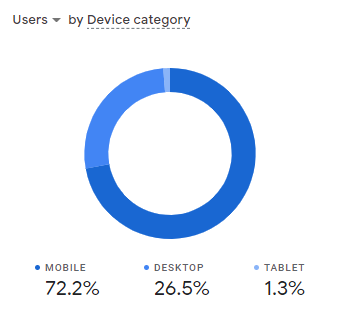
Users by Country / Users by City shows the number of users from top countries and cities. With each country and city location, you can drill into the user counts to examine engagement, conversions, and revenue.
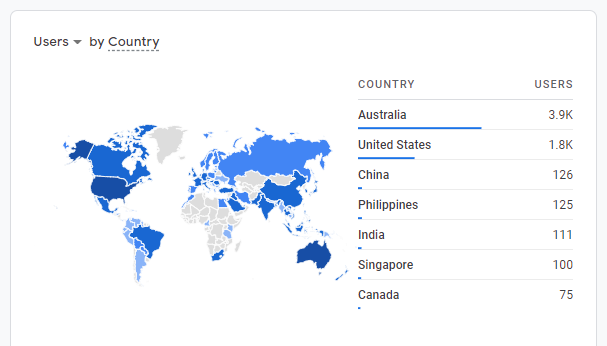
Channel groupings are rule-based definitions of your website’s traffic sources that let you monitor the performance of all of the channels sending traffic to your website.
